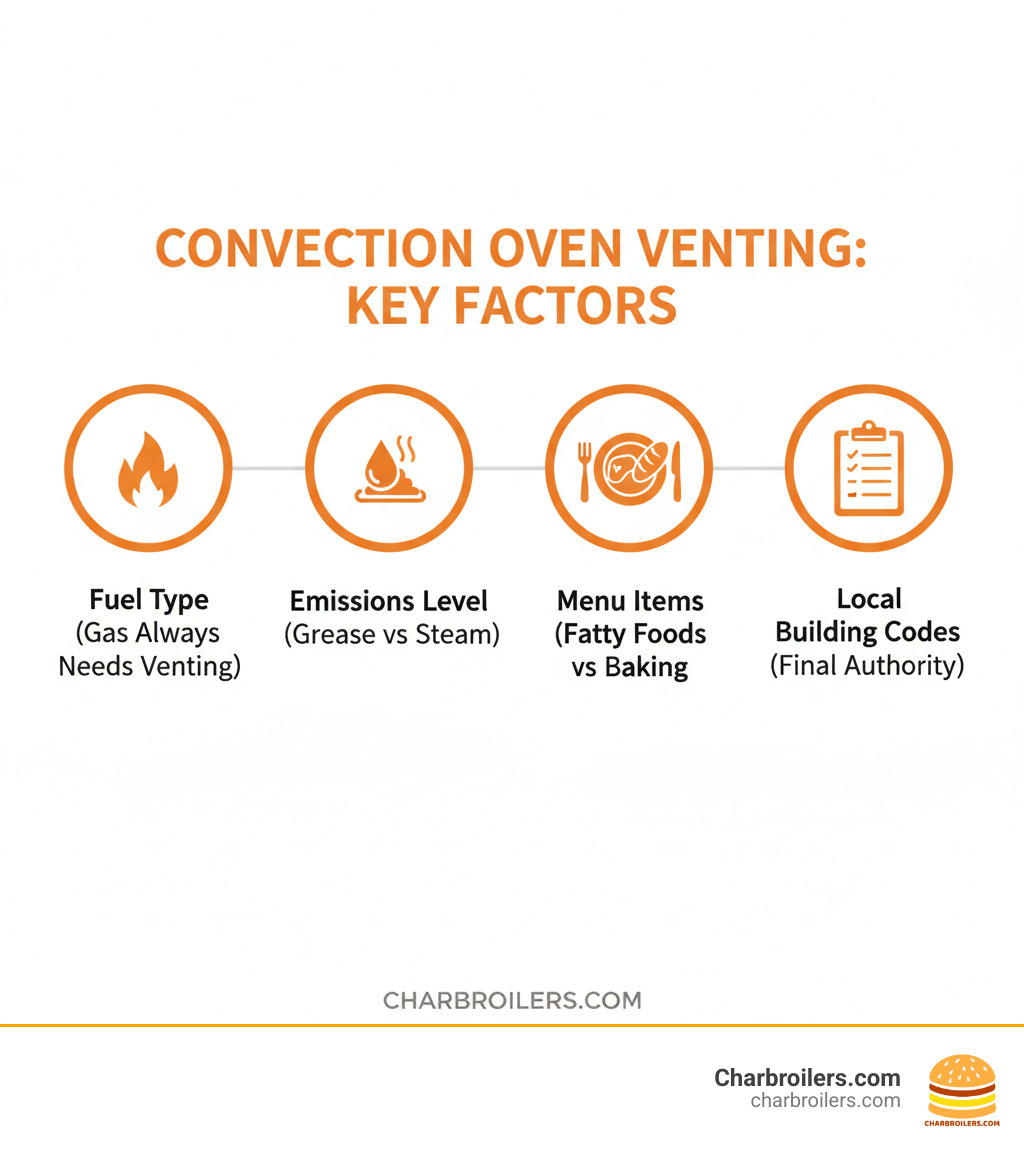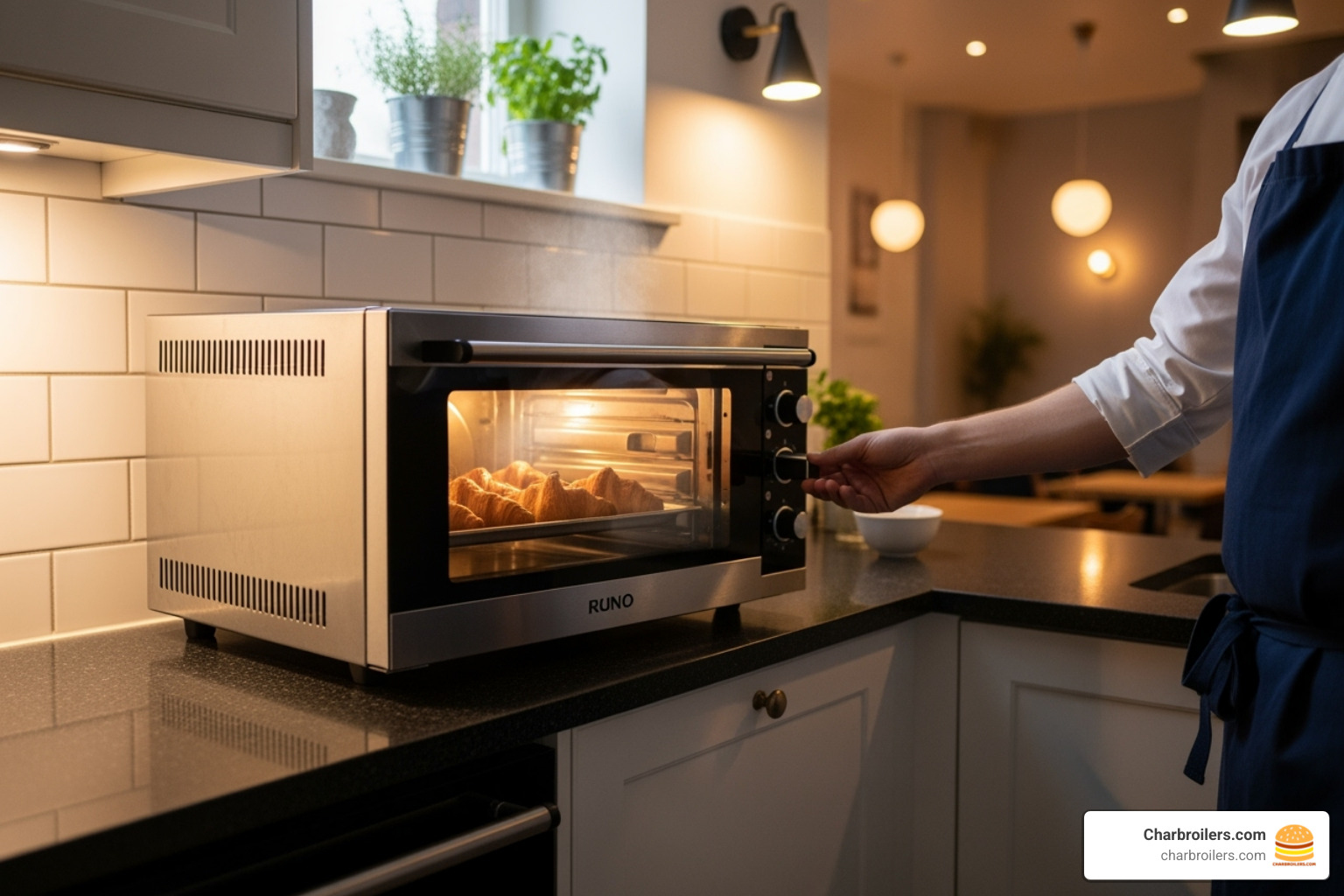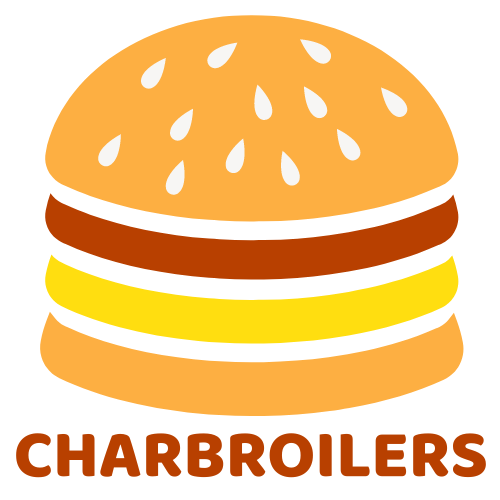
Commercial Convection Ovens: Unpacking Venting and Hood Requirements
Share
Understanding Commercial Convection Oven Venting Requirements
Do commercial convection ovens need venting? The answer depends on several key factors:
Most common scenarios:
- Gas convection ovens: Always require venting (Type I hood)
- Electric convection ovens cooking fatty foods: Require Type I hood
- Electric ovens for baking only: May qualify for exceptions or a Type II hood
- Ventless certified models: May not require traditional hoods
Key determining factors:
- Fuel type - Gas vs. electric
- Food being cooked - Fatty meats vs. baking
- Emissions produced - Grease, smoke, steam
- Local building codes - The final authority on requirements
Getting ventilation wrong can lead to fines, failed inspections, or even business closure. While a Type I hood can cost over $1,000 per linear foot, getting it wrong costs more. Here's what many restaurant owners find out too late: your local fire marshal and health inspector have the final say—not the equipment manual or your contractor.
I'm Sean Kearney from Charbroilers.com. With over a decade in the restaurant equipment industry, I've helped countless operators steer ventilation requirements and avoid costly mistakes. My experience has shown that getting ventilation right from the start saves money and headaches.

Do commercial convection ovens need venting terms to learn:
- commercial convection ovens
- full size commercial countertop convection oven
- commercial electric range with convection oven
Why Proper Ventilation is a Non-Negotiable in Commercial Kitchens
Imagine a kitchen thick with steam, smoke, and a coat of grease on every surface. This isn't just unpleasant; it's a recipe for disaster that will attract citations from health inspectors.

Proper ventilation isn't just recommended—it's essential for kitchen safety and compliance. Here's why cutting corners is never worth the risk:
- Fire Safety: Grease-laden vapors are fuel waiting for a spark. Without proper removal, grease accumulates in ductwork, creating a serious fire hazard.
- Heat and Steam Removal: Commercial ovens generate intense heat and steam. A good ventilation system prevents your kitchen from becoming a sauna, which improves working conditions and reduces slip hazards.
- Employee Health and Comfort: A hot, smoky kitchen leads to tired, less productive employees and high turnover. Good ventilation creates a better work environment.
- Grease and Odor Control: A ventilation system captures grease vapors before they coat your kitchen surfaces. It also prevents cooking smells from lingering and affecting the dining experience.
- Health Code Compliance: Local health departments have strict air quality standards. Proper ventilation is non-negotiable for passing inspections.
The High Cost of Cutting Corners
Trying to save money on ventilation often leads to much higher costs later. The consequences can be devastating:
- Failed Inspections and Fines: Health departments and fire marshals issue fines for ventilation violations, and you'll still have to fix the problem.
- Business Closure: Authorities can shut you down immediately if your ventilation poses a safety hazard, leading to lost revenue and a damaged reputation.
- Fire Hazards: Grease fires spread incredibly fast and can destroy your business.
- Equipment Damage and Increased Insurance: Grease buildup shortens the lifespan of your equipment, and inadequate ventilation is a major risk factor that will increase your insurance premiums.
Understanding Hood Types: Type I vs. Type II
Choosing the wrong hood can leave you non-compliant. Understanding the difference between Type I and Type II hoods is crucial.

Type I hoods are heavy-duty systems designed for grease and smoke capture. They are required for equipment like fryers, griddles, charbroilers, and most commercial convection ovens. They are built with fire-resistant materials and include mandatory fire suppression systems.
Type II hoods focus on steam and heat removal. They are suitable for equipment like dishwashers or steamers where grease is not a primary byproduct. They are less expensive but cannot handle the demands of most cooking equipment.
The key distinction is that Type I hoods prevent fires, while Type II hoods prevent condensation. Most commercial convection ovens require Type I hoods because they can produce both heat and grease-laden vapors. Always consult the International Mechanical Code and your local authorities before making a decision.
So, Do Commercial Convection Ovens Need Venting? The Deciding Factors
While most commercial convection ovens must be under a Type I hood, the answer to do commercial convection ovens need venting isn't one-size-fits-all. The final requirement depends on several interacting factors.
Your oven's fuel type sets the baseline, while emission levels and your food products determine what vapors are created. Manufacturer specifications show what the equipment is certified for, but local codes have the final say.
For a deeper dive into choosing the right equipment, check out The Ultimate Guide to Comparing Commercial Convection Ovens.
Gas vs. Electric: A Critical Distinction
The power source is one of the clearest dividing lines in the venting discussion.
Gas convection ovens almost always require a Type I hood. Burning natural gas or propane creates combustion byproducts like carbon monoxide that must be vented for safety. Combined with heat, steam, and cooking vapors, venting becomes non-negotiable. I have yet to see a jurisdiction that allows unvented gas-fired commercial cooking equipment. If you're considering gas, our guide Open up Culinary Excellence: Exploring Commercial Gas Ranges with Convection Ovens can help.
Electric convection ovens offer more flexibility. With no combustion, you're mainly dealing with heat, steam, and cooking vapors. While many electric units still need a Type I hood (especially for greasy foods), this is where exceptions may apply. Depending on the oven's design and local codes, an electric oven might qualify for a Type II hood or even ventless operation, but this must be verified with local authorities.
How Your Menu Influences Venting Needs
What you cook is just as important as the equipment you use.
If your menu features high-fat foods like bacon or fatty roasts, you're producing grease-laden vapors and smoke. For these applications, a Type I hood with robust grease filtration and fire suppression is almost certainly required. For perspective on equipment that needs heavy-duty ventilation, see our Flip, Grill, and Thrill: Best Commercial Oven with Griddle Picks.
Baking and pastry operations are different. Cooking bread, cakes, and other low-fat items mainly produces heat and steam. In some jurisdictions, an electric convection oven used exclusively for baking may qualify for a Type II hood or even be considered ventless, but only with certification and local approval.
Roasting vegetables falls in the middle, producing less grease than meats. Depending on the volume and oils used, this could potentially qualify for lighter ventilation requirements with local approval.
The bottom line: if your oven will ever be used for high-fat items, plan for a Type I hood unless you get explicit, written approval from local officials for an alternative.
The Rise of Ventless Technology: An Alternative to Traditional Hoods
For small cafes or front-of-house applications, installing a massive hood system can be impractical. Ventless technology has changed the game, offering a powerful alternative.

Ventless convection ovens answer the question of do commercial convection ovens need venting with a resounding "not necessarily!" These units have built-in systems that clean the air, eliminating the need for external ductwork.
The magic is in the internal technology. Catalytic converters break down grease and odors into harmless carbon dioxide and water. For example, the Merrychef eikon e2s High-Speed Oven achieves ventless cooking this way. Condensation technology captures steam, while recirculating air systems filter and clean the air before returning it to the kitchen.
To qualify as ventless, these ovens must meet strict standards like the EPA's Method 202 guidelines, which limit grease emissions. Independent agencies like Intertek test and verify these claims.
If you're curious about specific models, our guide to Ventless Commercial Convection Ovens That'll Blow You Away (Without the Vent) dives into the best options.
Comparing Vented vs. Ventless Convection Oven Systems
Understanding the differences between vented and ventless systems helps you make the right choice:
| Feature | Vented Convection Oven System | Ventless Convection Oven System |
|---|---|---|
| Installation Costs | High ($1,000-$2,000+ per linear foot for Type I hood, plus ductwork, fire suppression, labor). | Significantly lower (no external ductwork or traditional hood installation). |
| Location Flexibility | Limited (must be placed under a hood, near an external wall for ducting). | High (can be placed almost anywhere, even in front-of-house). |
| Upfront Equipment Cost | Oven cost + separate hood system cost. | Often higher initial oven cost due to integrated technology. |
| Maintenance Needs | Regular hood and duct cleaning (fire hazard), filter replacement. | Filter replacement (charcoal, catalytic), internal cleaning. |
| Energy Consumption | Exhaust fans consume energy; conditioned air is expelled, increasing HVAC load. | Recirculates air, potentially reducing HVAC load; the oven itself may be more efficient. |
| Kitchen Footprint | Oven footprint + hood footprint. | Oven footprint only (built-in hood). |
While ventless ovens often cost more upfront, they can save thousands in installation and offer best placement flexibility.
Key Features of a Reliable Ventless Oven
When shopping for a ventless oven, look for these key features:
- UL-certification for ventless operation (UL 710B) proves the oven has passed rigorous independent testing.
- NSF listing ensures the oven meets public health and safety standards.
- Easy filter access and cleaning is crucial for regular maintenance.
- Self-diagnostics alert you when filters need changing or service is required.
- Integrated fire suppression provides an extra layer of safety.
- EPA Method 202 compliance should be explicitly stated by the manufacturer.
Choosing the right ventless oven can transform your kitchen's flexibility. For more insights, explore our guide Convection Perfection: Top Ovens for Your Commercial Kitchen.
Navigating Codes and Best Practices for Your Convection Oven
Even with clear guidelines, the ultimate authority on whether do commercial convection ovens need venting rests with your local officials. Navigating these codes is like following a recipe: you need the right ingredients (equipment specs) and final approval from the head chef (your local inspector).

Beyond approval, best practices like regular cleaning and proper food placement will keep your oven running efficiently and reduce smoke. If you're using multiple ovens, you must calculate the total ventilation needs (CFM), as each oven adds to the exhaust requirements.
The International Mechanical Code provides the foundation for most local codes, but local interpretations can vary.
The Final Say: The Role of Your Local Inspector
Here's the reality check: your local fire marshal, health department, and building code officials have the final word. What worked in one location may not be approved in another.
- Fire marshals focus on fire prevention, grease removal, and fire suppression.
- Health departments care about air quality and sanitation.
- Building code officials ensure the system is structurally and mechanically sound.
The smartest move is to submit plans for approval before you buy anything. Get it in writing. If you're considering a ventless model, have your inspector confirm that the specific make and model are acceptable for your intended use. This pre-purchase verification can save you from costly mistakes.
Best Practices to Minimize Smoke and Grease
Following these practices will make your kitchen safer and your ventilation system more effective:
- Clean your oven regularly: This is the most important step. A dirty oven is a smoky oven. Burnt-on food and grease create smoke and odors. Plan on deep cleaning every 4-8 weeks.
- Avoid overloading: Cramming too much food into the oven restricts airflow, leading to uneven cooking and potential smoke from burnt items.
- Use appropriate cookware: Stainless steel and aluminum work well in convection ovens. Ensure foil doesn't touch heating elements.
- Don't block internal fans: The fans need clear airflow to circulate heat properly. Blocking them causes hot spots and poor cooking results.
- Monitor cooking closely: Keep an eye on food, especially high-fat items or new recipes, to prevent burning and excess smoke.
Frequently Asked Questions about Convection Oven Venting
After years of helping restaurant owners, we've noticed the same questions about do commercial convection ovens need venting come up repeatedly. Here are straightforward answers to the most common concerns.
What determines if I need a Type I or Type II hood for my commercial convection oven?
The deciding factor is what your oven emits. If you cook anything that produces grease-laden vapors—like bacon, roasts, or other fatty proteins—you will need a Type I hood. These systems are designed to capture grease and include fire suppression systems to protect your business.
A Type II hood, which only handles heat and steam, might be sufficient if your oven is used exclusively for low-grease operations like steaming or baking plain bread. However, this is a rare exception. Always verify with your local health and fire departments before assuming you don't need a Type I hood.
I only bake bread and pastries. Do my commercial convection ovens need venting?
This is a scenario where exceptions often apply, particularly for electric convection ovens. Baking primarily produces steam and heat, not grease. Some jurisdictions may allow electric bakery ovens to operate with a simpler Type II hood or, in some cases, without a traditional hood at all.
Some specialized ovens with catalytic converters are designed for ventless bakery use. However, you cannot make this decision on your own. You must obtain written approval from your local authorities before proceeding. Provide them with your oven's specifications and your planned menu to ensure you are compliant with local codes.
Can I install a commercial convection oven myself to save money?
While it's tempting to save on installation costs, commercial kitchen equipment installation is not a DIY project. It involves high-voltage electrical connections, gas lines, and integration with ventilation systems. A single mistake can lead to gas leaks, fires, or dangerous carbon monoxide buildup.
Furthermore, improper installation will void your warranty and violate local building codes, guaranteeing a failed inspection. You'll end up paying a professional to fix it anyway, adding to your costs.
Licensed professionals understand local codes, ensure safety, and provide the documentation needed for inspections and insurance. The upfront cost of professional installation is an investment in your business's safety, compliance, and long-term success. It's a cost that is always worth it.
Conclusion: Making the Right Choice for Your Kitchen
So, do commercial convection ovens need venting? The answer depends on your specific situation. This complexity is why so many restaurant owners get tripped up.
Here's a summary:
- Gas convection ovens always need venting due to combustion fumes.
- Electric ovens cooking fatty foods typically need a Type I hood for grease vapors.
- Electric ovens used only for baking might qualify for lighter ventilation requirements.
- Certified ventless models can sometimes bypass traditional hoods entirely.
However, the most critical takeaway is that your local fire marshal and health inspector have the final say. They are responsible for public safety and ensuring your business operates legally.
The investment in proper ventilation may seem high, but the alternative—failed inspections, fines, or business closure—is far more costly. We've seen many operators try to cut corners only to pay more in the long run.
Your best strategy is to do your homework early. Before buying equipment, get your local authorities involved. Show them your specs, explain your menu, and get their requirements in writing. This single step can save you thousands of dollars and significant headaches.
Modern ventless technology offers exciting flexibility for small or non-traditional spaces, but even these advanced ovens require local approval. Whether you choose a traditional or ventless system, make an informed decision based on your needs, local codes, and business goals. At Charbroilers.com, we're here to help you find the right equipment for your operation.
Ready to equip your kitchen for success?
Explore our comprehensive guide to commercial charbroilers and other essential restaurant equipment.
